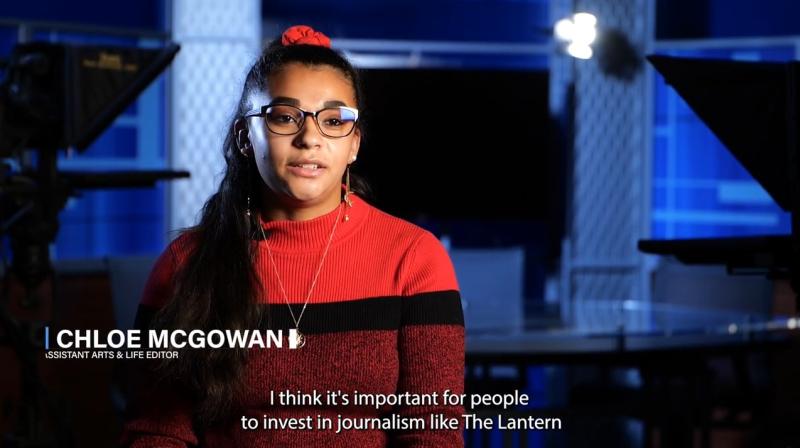Public Affairs Journalism (PAJ) teaches you how to investigate and disseminate news. Our multimedia focus prepares you to integrate this training with the multimedia skills necessary for packaging news stories with word, still photo, audio and video.
As a journalism student, you also are taught to consider the context in which you will practice the field, including an understanding of the social, legal and ethical implications that all journalists encounter.
Major Curriculum
Required Pre-Major Courses: 6 credit hours (do not count in major)
All students must complete two pre-major courses. A grade of C- or better is required in both courses for a Major Specialization Application to be considered. Admission is competitive and an online application is required.
Journalism Direct Admission students should contact their advisor for information about the program review process.
- Comm 1100: Communication in Society
- Comm 1101: History of Communication
Core Major Requirements: 19 credit hours. All five courses required.
- Comm 2221: Media Writing and Editing
- Comm 2223: Lantern Practicum
- Comm 3226: Multimedia Journalism
- Comm 3404: Media Law and Ethics
- Comm 4221: Data Journalism in Enterprise Reporting (prereq of Comm 3160/3163 is highly recommended)
Research Method Requirement: 4 credit hours. Choose one of the following:
- Comm 3160: Communication Research Methods (prereq: Stats 1350, 1450 or equiv.)
- Comm 3163: Communication Industry Research Methods (prereq: Stats 1350, 1450 or equiv.)
Critical Thinking Skills: 6 credit hours. Chose at least courses from this list:
- Comm 3402: Crime and the News Media
- Comm 3440: Mass Communication and Society
- Comm 3597.01: International Perspectives on Communication
- Comm 3597.02: Media and Terrorism
- Comm 4240: Science Communication
- Comm 4814: Political Communication
- Comm 4820: Public Opinion and Communication
Required Internship: 3 credit hours required.
- Comm 4191*: Internship (1-3 credits, repeatable)
Required Minor: 12 credit hours (required hours vary by minor program)
Students should declare the minor by the end of their first semester in the major. Students will select an approved minor from this list in order to develop knowledge in a content area:
- Business
- Business Analytics
- Campaigns and Elections
- Capital Program
- Criminology & Criminal Justice Studies
- Economics
- Geographic Information Science
- Geography
- International Studies
- Media Production & Analysis
- Political Science
- Public Policy
- World Politics
Students who feel that a different minor will better relate to their journalism career goals must receive approval from the School of Communication before the minor is declared. A written petition detailing the way in which the unapproved minor provides domainspecific expertise that aligns with career goals must be submitted. Not all petitions are approved. Please contact commadvising@osu.edu for more information.
General Education requirements for the Bachelor of Arts in Journalism degree
Additional Information
Our students focus on reporting, interviewing, news writing and feature writing, as well as more interactive journalism such as blogging, micro blogging, social media and multimedia.
To better allow for domain-specific expertise, students in our journalism program complete a minor in an approved area-such as political science, international studies, business, criminology, etc.--that best fits their interests.
All journalism students further hone their "real-world" skills by working on our pride-and-joy publication, The Lantern, named Ohio's Best College Newspaper, as well as by participating in a journalism-related internship.
The Lantern has been an institution at Ohio State since 1800’s. Since then, it’s grown into a central pillar of our efforts to educate and train student journalists. The journalism program here stands out from other schools’ because the Lantern is a part of it.
Many journalism programs are strictly academic and the student newspaper on campus exists as a private or non- profit entity. The students who go through this program learn through practice. Their stories are read by thousands of people who provide reaction and offer feedback. This experience goes well beyond the classrooms, giving students a real-world work product and a level of experience that helps them effectively compete for internships with professional news organizations. Those internships are key to developing a journalism career.
And the work that is done here is top-notch. In 2017, our new editor in chief won the national award for sports writing in the SPJ’s Mark of Excellence contest. That award was for a story he researched and published with the help of an annual endowment The Lantern is honored to receive each year to sponsor an investigative reporter.
In 2016, during the Nov. 28 terrorism inspired attack on the OSU campus, The Lantern’s news staff earned national attention and recognition for its breaking news coverage. The Lantern’s use of social media and multimedia journalism drew a record audience. Our videos were featured in national broadcasts on ABC and CNN, and our reporters and photographers’ work were appeared in some of the nation’s largest newspapers.
Kudos regarding the students’ achievements followed, including this write-up by the Poynter journalism institute.
Graduates leaving our journalism program are equipped through our extensive array of classes to enter the workplace as a multimedia journalist, ready to step directly from our classrooms into a newsroom.

